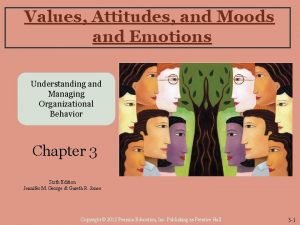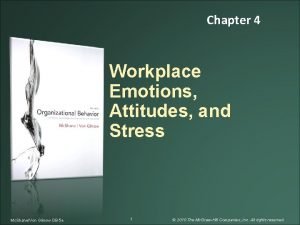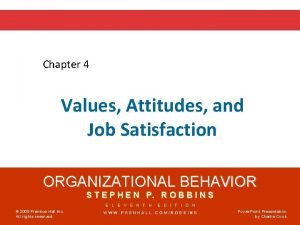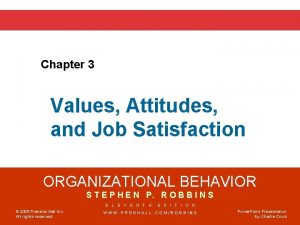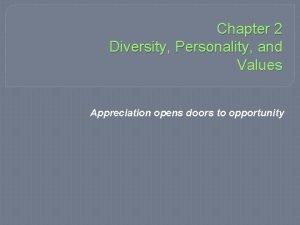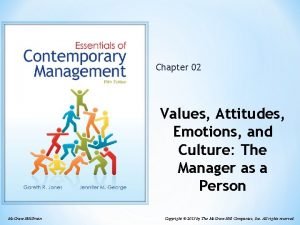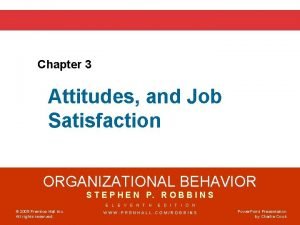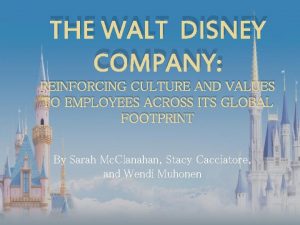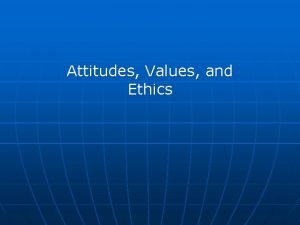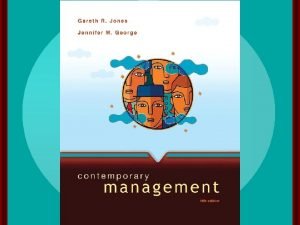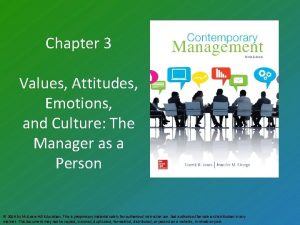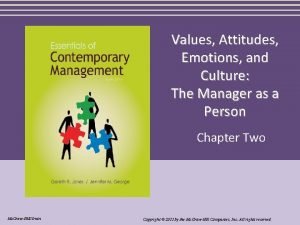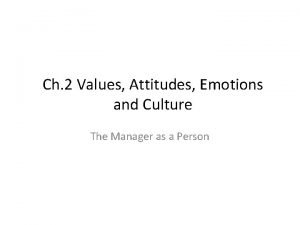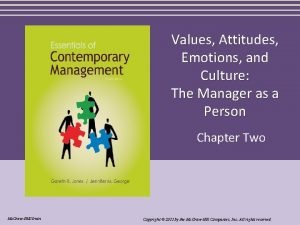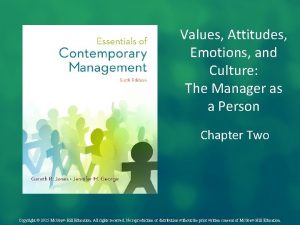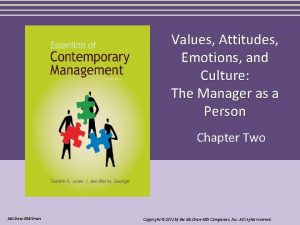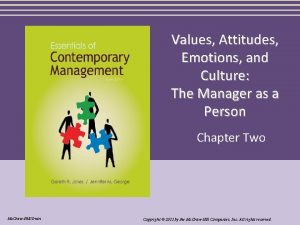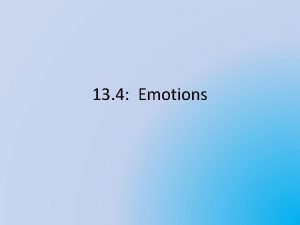Chapter 3 Values Attitudes Emotions and Culture The















- Slides: 15

Chapter 3 Values, Attitudes, Emotions and Culture: The Manager as a Person

Big Five Personality Traits MGMT 321 – Chapter 3

Big Five Personality Traits n Extroversion – Sociable, positive, assertive n Negative affectivity – Distressed, critical n Agreeableness – Cooperative, warm n Conscientiousness – Dependable, hardworking, honest n Openness to experience – Creative, curious, risk-taker MGMT 321 – Chapter 3

Other Personality Traits n Locus of Control – Internal – I control what happens to me – External – Forces outside my control (fate, chance, other people) determine what happens to me n Self-Esteem – Determination of self-worth – with success and with failures MGMT 321 – Chapter 3

Mc. Clelland’s Needs n Need for Achievement – Need for excellence, competition, challenging goals, persistence, and overcoming difficulties n Need for Affiliation – Need to establish and maintain warm, close, intimate relationships with other people n Need for Power – Need to make an impact on others, influence others, change people or events, and make a difference in life MGMT 321 – Chapter 3

Values, Attitudes, and Moods and Emotions n Values – Describe what managers try to achieve through work and how they think they should behave n Attitudes – Capture managers’ thoughts and feelings about their specific jobs and organizations n Moods and Emotions – Encompass how managers actually feel when they are managing MGMT 321 – Chapter 3

Values n Terminal Values – A personal conviction about life-long goals n Instrumental Values – A personal conviction about desired modes of conduct or ways of behaving n Value System – What a person is striving to achieve in life and how they want to behave MGMT 321 – Chapter 3

Terminal vs. Instrumental Values MGMT 321 – Chapter 3

Work Attitudes n Job Satisfaction – A collection of feelings and beliefs that managers have about their current jobs – Dimensions include the work, supervision, pay, promotion opportunities, and coworkers n Organizational Citizenship Behavior – Behavior that is above and beyond duty – Related to job satisfaction MGMT 321 – Chapter 3

Work Attitudes n Organizational – Affective – Normative – Continuance commitment n Effects – Turnover – Individual performance – Firm performance MGMT 321 – Chapter 3

Moods and Emotions n Mood – A feeling or state of mind • Positive moods provide excitement, elation, and enthusiasm • Negative moods lead to fear, distress, and nervousness n Emotions – Intense, relatively short-lived feelings MGMT 321 – Chapter 3

A Measure of Positive and Negative Mood at Work MGMT 321 – Chapter 3

Emotional Intelligence n The ability to: – Understand manage one’s own moods and emotions – And understand the moods and emotions of other people n Assists in carrying out various roles n Higher levels of EI result in better decision making MGMT 321 – Chapter 3

Organizational Culture n Shared set of beliefs, expectations, values, norms, and work routines n Influences: – How organizational members relate to one another – How organizational members work together to achieve organizational goals n Attraction-Selection-Attrition MGMT 321 – Chapter 3

Factors Affecting Organizational Culture MGMT 321 – Chapter 3
 Emotions and values
Emotions and values Emotions and attitudes in a workplace
Emotions and attitudes in a workplace Workplace emotions, attitudes, and stress
Workplace emotions, attitudes, and stress The globe framework for assessing cultures
The globe framework for assessing cultures Nz attitudes and values study
Nz attitudes and values study Values and attitudes in the workplace
Values and attitudes in the workplace Values attitudes and job satisfaction
Values attitudes and job satisfaction Characteristics of quality culture
Characteristics of quality culture Terminal values and instrumental values
Terminal values and instrumental values Instrumental values
Instrumental values Organizational behavior chapter 3
Organizational behavior chapter 3 Disney values and culture
Disney values and culture Ethnocentrism examples
Ethnocentrism examples Batch culture vs continuous culture
Batch culture vs continuous culture Difference between american and indian culture
Difference between american and indian culture Stab and stroke culture
Stab and stroke culture
